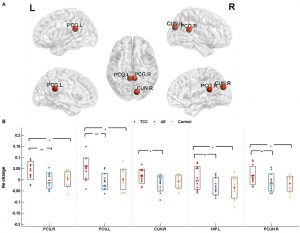Improve Well-Being of Traumatic Brain Injury Patients with Mindfulness
By John M. de Castro, Ph.D.
“TBI is a complex diagnosis involving many components.”One significant component is the stress response after having this type of injury. Mindfulness meditation appears to have a strong relaxing and stress reduction quality for patients, which is tremendously beneficial for overall recovery from injury.” – Heechin Chae
Brain damage is more or less permanent. The neurons and neural structures that are destroyed when the brain is damaged for the most part do not regrow. Brain Injury is caused by a number of different events including a violent blow to the head (Traumatic Brain Injury, TBI). In the United States it is estimated that annually 1.7 million people sustain Traumatic Brain Injury. Although the brain tissues that are destroyed are permanently lost, we know that people can recover to some extent from brain injury. How is it possible that recovery can occur when there is no replacement of the damaged tissue? There appears to be a number of strategies that are employed by the brain to assist in recovery. Other areas of the brain can take over some of the function, other behavioral strategies can be employed to accomplish the task, and non-injured areas of the brain can adapt and change to compensate for the lost function. Rehabilitation for brain injury patients usually involves strategies to promote these recovery mechanisms. Mindfulness training has been found to be helpful in recovery from Traumatic Brain Injury.
In today’s Research News article “Comparison of the effects of transcranial direct current stimulation and mindfulness-based stress reduction on mental fatigue, quality of life and aggression in mild traumatic brain injury patients: a randomized clinical trial.” (See summary below or view the full text of the study at: https://www.ncbi.nlm.nih.gov/pmc/articles/PMC8207739/ ) and Shirvani colleagues recruited adult patients with traumatic brain injury and randomly assigned them to either no treatment or to receive a once a week for 2 hours for 8 weeks program of Mindfulness-Based Stress Reduction (MBSR) or 3 sessions of 20 minutes per week for 10 total sessions of transcranial direct current stimulation (tDCS). They were measured before and after training and 2 months later for mental fatigue, quality of life, physical aggression, verbal aggression, anger, and hostility.
They found that in comparison to baseline and the control group both the Mindfulness-Based Stress Reduction (MBSR) and transcranial direct current stimulation (tDCS) groups had significantly lower levels of mental fatigue and aggression both after treatment and 2 month later but the MBSR group has a significantly greater improvement than the tDCS group in mental fatigue but not aggression. They report that only the MBSR group has a significantly greater improvement in quality of life.
In the present study mental fatigue, quality of life, and aggressive behaviors were improved immediately after treatment and 2 month later by both Mindfulness-Based Stress Reduction (MBSR) and transcranial direct current stimulation (tDCS). But MBSR produced greater improvement in mental fatigue and only MBSR produced a significant improvement in quality of life. Mindfulness has been shown in prior research to produce improvements in fatigue, aggression, and quality of life. The present study extends these benefits to patients with traumatic brain injury.
Traumatic brain injury patients are particularly difficult to treat. But the present findings suggest that mindfulness training may not only be effective but be the best treatment to improve the behavior and cognitive ability of patients with traumatic brain injury. Importantly, the improvements are relatively long lasting.
So, improve well-being of traumatic brain injury patients with mindfulness.
“Mindfulness is a technique used to concentrate on your immediate surroundings, focusing on what happens moment by moment. It can be transformative for some and allow them to feel more aware of the situations around them, which can be particularly helpful for brain injury survivors.” – Headway
CMCS – Center for Mindfulness and Contemplative Studies
This and other Contemplative Studies posts also available on Google+ https://plus.google.com/106784388191201299496/posts and on Twitter @MindfulResearch
Study Summary
Shirvani, S., Davoudi, M., Shirvani, M., Koleini, P., Hojat Panah, S., Shoshtari, F., & Omidi, A. (2021). Comparison of the effects of transcranial direct current stimulation and mindfulness-based stress reduction on mental fatigue, quality of life and aggression in mild traumatic brain injury patients: a randomized clinical trial. Annals of general psychiatry, 20(1), 33. https://doi.org/10.1186/s12991-021-00355-1
Abstract
Background
The rate of traumatic brain injuries (TBIs) due to the accidents is high around the world. Patients with mild TBIs may suffer from some psychological disorders, including aggression, and mental fatigue, and thus their quality of life decreased. Among different treatments for TBI, two treatments, namely transcranial direct current stimulation (tDCS), and mindfulness-based stress reduction (MBSR) have shown to be effective. Therefore, this study aimed to compare the effects of these two treatments on mental fatigue, aggression and quality of life in mTBI patients.
Materials and methods
This randomized controlled trial study was conducted on 48 TBI patients referred to emergency and neurosurgery departments of Shahid Beheshti Hospital, Kashan, Iran. They were selected using the convenience sampling method. Data were collected using the mental fatigue scale, the World Health Organization Quality of Life-BREF (short version), and the Buss–Perry Aggression Questionnaires. Then, the data were analyzed using a Mixed Repeated Measures ANOVAs, and the Levene and Kolmogorov–Smirnov tests by SPSS-23 software.
Results
The mean age of patients in the three groups of MBSR, tDCS and control were 69.38 + 6.11 (25% male), 25.40 + 12.11 (25% male) and 69.37 + 0.2 (18.8% male), respectively. There was no significant difference between the three groups in terms of mental fatigue, quality of life and aggression (P < 0.05). In addition, the results showed that there was a significant difference between the main effect of time and the interaction between time and group (P < 0.001).
Conclusions
Both MBSR and tDCS methods are effective in reducing the mental fatigue and aggression and increasing quality of life of mTBI patients; MBSR treatment, as indicated in the present study, can be more effective than tDCS in patients with mTBI.
https://www.ncbi.nlm.nih.gov/pmc/articles/PMC8207739/









